Calving Book (AS1954, June 2020)
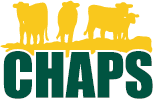
CHAPS™ (Cow Herd Appraisal Performance Software) is a web-based recordkeeping and analysis application for cow-calf operations.
CHAPS™ can help producers track inventories, evaluate cow profitability, and monitor herd reproduction and calf performance.
The North Dakota Beef Cattle Improvement Association is committed to the well-being and continued success of the beef industry through programs such as CHAPS.
For more information about CHAPS, visit www.ndsu.edu/chaps.

Why Keep a Calving Book?
A calving book provides:
- An inventory of cows in the herd and calves produced for management and marketing decisions
- Cattle identification in conjunction with calving and weaning information, which is the basis for evaluating cow productivity and herd reproduction
- Details on health care, bull turnout dates and breeding records of the animals in a beef cow herd
Resource Contact List
NDSU Extension Beef Specialists
Karl Hoppe
Carrington Research Extension Center
701-652-2951
karl.hoppe@ndsu.edu
Janna Block
Hettinger Research Extension Center
701-567-4323
janna.block@ndsu.edu
On Campus
701-231-7641
ndsu.ansc@ndsu.edu
NDSU Extension Beef Quality Assurance Specialist
Lisa Pederson
701-328-9718
lisa.pederson@ndsu.edu
NDSU Extension Veterinarian
Gerald Stokka
701-231-5082
gerald.stokka@ndsu.edu
Calving Records
Calving Ease (CE) Codes
1 = No difficulty, no assistance
2 = Minor difficulty; some assistance
3 = Major difficulty; usually mechanical assistance
4 = Caesarean section
5 = Abnormal presentation
Sex Codes
0 = Miscellaneous (assigned for management codes A, B and C, and D if sex is unknown)
1 = Bull
2 = Heifer
3 = Steer
International Year Letter Codes
2007 T
2008 U
2009 W
2010 X
2011 Y
2012 Z
2013 A
2014 B
2015 C
2016 D
2017 E
2018 F
2019 G
2020 H
2021 J
2022 K
2023 L
2024 M
2025 N
2026 O
2027 P
2028 Q
2029 R
2030 S
2031 T
2032 U
2033 V
2034 W
Management Codes(MC)
0 = no creep feed
1-7 = months actual creep fed
A = cow that didn’t calve but kept in herd
B = cow aborted
C = calf died before 2 weeks of age
D = calf died after 2 weeks but before weighing
E = embryo transplant
F = purchased calf
N = calf that was in herd but raised by another cow
K = twin, raised on foster cow with known birthdate
S = twin, raised on own dam as single
T = twin, raised on own dam as twin
X = calf present but not weighed
|
Calf ID |
Cow ID |
Sex |
Sire |
DOB |
BW |
|
CE |
MC |
Notes |
Calving Summary
|
Item |
Days 1-30 |
Days |
Days 61-90 |
Days |
|
Cows calved |
||||
|
Calves lost |
||||
|
Birth difficulty |
||||
|
Scours |
||||
|
Illness |
||||
|
Malnutrition |
||||
|
Other__________ |
||||
|
_________________ |
||||
|
_________________ |
||||
|
_________________ |
||||
|
# Heifer calves |
||||
|
# Steer calves |
||||
|
# Bull calves |
||||
|
Comments |
||||
Health Records
The success of a beef operation depends on the health of your beef animals. Healthy cattle grow better. They also adapt to environmental changes faster and more easily.
An active health management protocol is very important. A key component of any health protocol involves a relationship with the local veterinarian, which includes regular dialogue.
Disease control and prevention, animal traceback and good-quality beef products for consumers require collaboration along the entire beef industry chain.
Keep a record of vaccinations, antimicrobials and parasiticids administered to cattle. Keeping this type of information can increase the value of your animals.
Processing
Processing information helps you provide a complete “picture” of how you manage your animals . Work with your veterinarian to develop a complete herd health program for your animals.
Most herds process different classes of cattle (calves, cows, bulls or replacement heifers) the same so recording individual ID is not needed. A suggested method could be “Repl Heifers, Red #124-237.”
However, sometimes individual animals are not processed along with others because of some underlying condition such as too young, sick or injured. The ID’s of these animals can be noted as NOT processed. A suggested method could be “Not Processed Repl Heifer #195, running fever.”
Processing
DATE PROC – date of processing
PROD – product name, serial number
IDs of animals NOT processed – When recording information, it is often easier to record which animals were NOT processed on that day and record them as a “Treatment” at a later date.
BY WHOM – person administering product
|
Date Proc. |
Product, Dose and Serial # |
Processed Group Animal ID’s OR Not Processed |
W/D Days |
By Whom |
Treatment
Recording the treatment of animals should be on an individual basis. Not all animals will respond the same. Work with your veterinarian to develop a standardized treatment protocol for the different types of animals within your herd. A treatment program is part of a complete herd health program for your animals.
Treatment
DATE ADMIN – date treatment was administered
ID – animal’s identification
DX – Following are recommendations for diagnosis and treatment:
R - respiratory
P - pinkeye
F - footrot
S - structural (ex: leg, hip)
U - reproductive (ex: metritis, retained placenta)
M - metabolic (ex: grass tetany, milk fever)
O - other
PROD – product name, serial number
WD DAYS – product withdrawal days
BY WHOM – person administering product
| Date Admin. | ID | Dx Code | Prod., Dose and Serial # | W/D Days | By Whom |
™ Cow Culling Codes
The collection of performance data in beef cattle has helped the industry move forward to evaluate many different traits. In addition to direct economic evaluations, producers can assess resource usage and benefits indirectly.
Another major benefit of performance data is the ability to evaluate traits that can be useful in improving the quality of beef products sold to consumers.
G = cow died
H = cow sold, age
J = cow sold, physical defect
K = cow sold, poor fertility or open
L = cow sold, inferior calves
R = cow sold, replacement stock
Y = cow sold, unknown
Culling Records
|
Date |
Animal |
Culling Code |
Beef Improvement Federation (BIF) Body Condition Scoring (BCS) for Beef Cattle
(Richards et al., 1986. J. Anim. Sci. 62:300.)
Condition BCS Description
Thin
1: Emaciated – The cow is extremely emaciated, with no palpable fat detectable over the spinous processes, transverse processes, hip bones or ribs. The tail head and ribs project quite prominently.
2: Poor – The cow still appears somewhat emaciated but the tail head and ribs are less prominent. Individual spinous processes still are rather sharp to the touch, but some tissue cover exists over the dorsal portion of the ribs.
3: Thin – Ribs still are individually identifiable but not quite as sharp to the touch. Obvious palpable fat is along the spine and over the tail head, with some tissue cover over the dorsal portion of the ribs.
4: Borderline – Individual ribs no longer are visually obvious. The spinous processes can be identified individually on palpation but feel rounded rather than sharp. Some fat cover is over the ribs, transverse processes and hip bones.
Optimum/moderate
5: Moderate – The cow has a generally good overall appearance. On palpation, the fat cover over the ribs feels spongy and areas on either side of the tail head have palpable fat cover.
6: High moderate – Firm pressure needs to be applied to feel the spinous processes. A high degree of fat is palpable over the ribs and around the tail head.
Fat
7: Good – The cow appears fleshy and obviously carries considerable fat. Very spongy fat cover is over the ribs and around the tail head. In fact, “rounds” or “pones” are beginning to be obvious. Some fat is around the vulva and in the crotch.
8: Fat – The cow very fleshy and over-conditioned. Spinous processes are almost impossible to palpate. The cow has large fat deposits over the ribs, around the tail head and below the vulva. “Rounds” or “pones” are obvious.
9: Extremely fat – The cow is obviously extremely wasty and patchy and looks blocky. The tail head and hips are buried in fatty tissue and “rounds” or “pones” of fat are protruding. Bone structure no longer is visible and barely palpable. The animal’s mobility even might be impaired by large fatty deposits.

Body Condition Scoring (BCS)
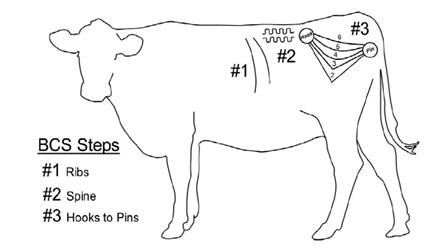
U.S. Beef
Body Condition Scores: Range from 1-9
BCS 1: Starved
BCS 9: Obese
1. Look at last two ribs
- Visible: <5
- Not visible: ≥ 5
2. Spine
- Visible: ≤ 3
3. Shape between hooks and pins (thurl)
- Shallow U: BCS 6
- Strong U: BCS 5
- V Shape: BCS 4
- Strong V: BCS 3
- Very Strong V: BCS 2
3-Step Body Condition Scoring (BCS) Guide for Range Cattle (B-1294), Scasta, et al, 2016,
University of Wyoming Extension. http://www.wyoextension.org/publications/html/B1294/
A Look at BCS-Cows
 3-Step Body Condition Scoring (BCS) Guide for Range Cattle (B-1294), Scasta, et al, 2016, University of Wyoming Extension. http://www.wyoextension.org/publications/html/B1294/
3-Step Body Condition Scoring (BCS) Guide for Range Cattle (B-1294), Scasta, et al, 2016, University of Wyoming Extension. http://www.wyoextension.org/publications/html/B1294/
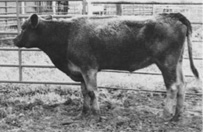
Last two ribs visible: BCS <5
Spine visible: BCS ≤3
Shape between hooks and pins is strong V: BCS 3
BCS 3
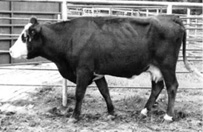
Last two ribs visible: BCS <5
Spine not visible: BCS >3
Shape between hooks and pins is V: BCS 4
BCS 4
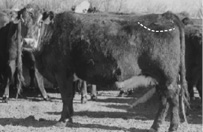
Last two ribs not visible: BCS ≥5
Spine not visible: BCS >3
Shape between hooks and pins is strong U: BCS 5
BCS 5
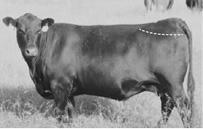
Last two ribs not visible: BCS ≥5
Spine not visible: BCS >3
Shape between hooks and pins is very shallow or flat U: BCS ≥6
BCS 6+
Gestation Table
Estimated calving date (283 days)
Breed Date / Calf Date
Jan. 1 / Oct. 11
Jan. 9 / Oct. 19
Jan. 17 / Oct. 27
Jan. 25 / Nov. 4
Feb. 2 / Nov. 12
Feb. 10 / Nov. 20
Feb. 18 / Nov. 28
Feb. 26 / Dec. 6
March 6 / Dec. 14
March 14 / Dec. 22
March 22 / Dec. 30
March 30 / Jan. 7
April 7 / Jan. 15
April 15 / Jan. 23
April 23 / Jan. 31
May 1 / Feb. 8
May 9 / Feb. 16
May 17 / Feb. 24
May 25 / March 4
June 2 / March 12
June 10 / March 20
June 18 / March 28
June 26 / April 5
July 4 / April 13
July 12 / April 21
July 20 / April 29
July 28 / May 7
Aug. 5 / May 15
Aug. 13 / May 23
Aug. 21 / May 31
Aug. 29 / June 8
Sept. 6 / June 16
Sept. 14 / June 24
Sept. 22 / July 2
Sept. 30 / July 10
Oct. 8 / July 18
Oct. 16 / July 26
Oct. 24 / Aug. 3
Nov. 1 / Aug. 11
Nov. 9 / Aug. 19
Nov. 17 / Aug. 27
Nov. 25 / Sept. 4
Dec. 3 / Sept. 12
Dec. 11 / Sept. 20
Dec. 19 / Sept. 28
Dec. 27 / Oct. 6
*Leap years: If the breed date is between May 22 (prior to leap year) and Feb. 28 (leap year), then subtract one day from calf date. Use www.timeanddate.com/date/dateadd.html to verify the calf date by adding 283 days to the breed date for specific years.
Local Extension Assistance Available
North Dakota State University Extension has a network of beef professionals available for all counties in North Dakota.
If you have questions about beef production, your local Extension agent is available to assist you or put you in touch with people knowledgeable about issues such as electronic identification, range management, cropping systems and waste management.
Also contact your local Extension agent for additional calving books. A complete listing of Extension agents is at www.ag.ndsu.edu/extension/directory/counties.


A Management Tool That Helps Beef Producers Connect With All Segments of the Beef Industry!

